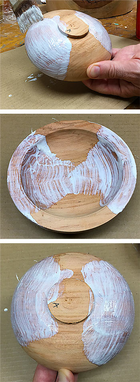Hi, I just roughed out a pretty big bowl. It already got some cracks, which if I were finish turning I would be fixing. Also some places where I can tell it's gonna wanna crack as it dries.
Should I just anchor seal it up and deal with it later, or should/can I start super glueing it up first then seal then dry? I'm thinking in the later case I may prevent further cracking. But I may also piss off the drying gods and introduce unholy stress.
As always thoughts and advice appreciated
Raif
Should I just anchor seal it up and deal with it later, or should/can I start super glueing it up first then seal then dry? I'm thinking in the later case I may prevent further cracking. But I may also piss off the drying gods and introduce unholy stress.
As always thoughts and advice appreciated
Raif

